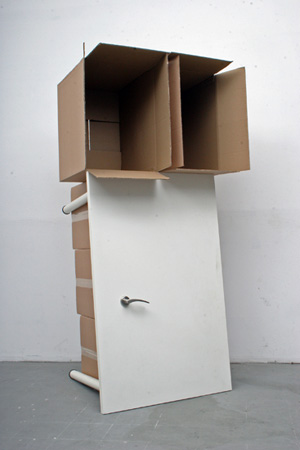See Thierry de Duve, “The Readymade and the Tube of Paint,” in Kant After Duchamp (Cambridge, MA: The MIT Press, 1996), 147–196.
Parallel to the “simple truth” television advertisements present us with by making commodities their main characters (notice the screen time humans receive versus objects in TV ads), contemporary romantic comedies focus on humans’ struggle to couple in a world of commodities, in which courting has transformed into a ritual of consumption structured by dating, status symbols, and lifestyle accessories.
Thierry de Duve, “The Readymade and the Tube of Paint,” 163.
Ibid.
The comparative display of cars in an automobile fair is an exhibition, too, and yet it is full of use- and exchange-value unlike that of the art exhibition. In the automobile fair, the commodity does not reveal itself as in an art exhibit. I thank Julia Moritz for stressing this point.
Robert Smithson, “Donald Judd,” in Robert Smithson, Collected Writings, ed. Jack Flam (Berkeley and Los Angeles: University of California Press, 1996), 4–7.
Sven Lütticken, “Attending to Abstract Things,” New Left Review 54 (November–December 2008): 120.
Following Freud’s speculation on the psychic equivalence of money with feces, Noam Yuran has made a beautiful and useful elaboration of this comparison with the help of Karl Marx, Thorstein Veblen, and Sándor Ferenczi. In a conference titled “Money and Soul” at the Freud Museum in Vienna in October 2010, Yuran addressed the notion of money as repression, using psychoanalysis and heterodox economics. While feces are the first social object, according to Freud, the money object embodies the social as absent from the sphere of experience, Yuran says. “The infant gives shit to his parents because of his love. With socialization we give money to people to make them strangers,” he concludes. Adding to Yuran, in the traditional psychoanalytic structure of ontogenetic and philogenesis, one can say that today the child moves from shit through an evolution of objects, but not to coins as Ferenczi suggested, but rather beyond them to a new baby accessory called Taggies—a blanket with labels that can be rubbed. The texture of the Taggies is the texture of brands; see →.
Andrea Philips, Julia Moritz and Luigi Fassi helped develop these notions in their presentations at “The Language of Things,” a discussion organized by Caterina Riva and FormContent at The Showroom in London (December 4, 2010). I thank them for their insights, and also Grant Watson for his remarks during the discussion.
From a conversation with the artist.
Lucy Lippard, Six Years: The Dematerialization of the Art Object from 1966 to 1972 (Berkeley and Los Angeles: University of California Press, 1997).
Joe Scanlan describes Weiner’s strategies in: Joe Scanlan, “Modest Proposals” Artforum, vol. 46 no. 8 (April 2008): 312–319; see →. In his text, Scanlan quotes Lucy Lippard reevaluating the notion of dematerialization in the 1978 MoMA exhibition of Sol Lewitt: “Some of the blame for this situation must fall on those who, like myself, had exaggerated illusions about the ability of a ‘dematerialization of the art object’ to subvert the commodity status and political uses to which successful American art has been subjected since the late 1950s. It has become obvious over the last few years that temporary, cheap, invisible or reproducible art has made little difference in the way art and artists are economically and ideologically exploited and that it can hardly be distinguished in that sense from Corten steel sculptures and twenty-foot canvases.”
See David Harvey, The Enigma of Capital and the Crisis of Capitalism (London: Profile Books, 2010), 21.
“Intelligence Agency: Sylvère Lotringer interviewed by Nina Power,” frieze 125 (September 2009): 104–107.
One can suggest a taxonomy of strategies, for example, the new objecthood and unreadymades of Rashawn Griffin, Mitzi Pederson, Ruri O’Cconnell, Gabriel Kuri, Gedi Sibony, and Michael Edward Smith; One can add the living (and dead) artist as an agent of commodification in the works of Rainer Ganahl, Christopher Williams, Roee Rosen, Francesco Finizio, and Josephine Meckseper; the site of work and labor in art in the works of Mierle Laderman Ukeles, Hito Steyerl and David Hammons; IKEA art and IKEA-hacking by artists as diverse as Maayan Strauss, Andrea Zittel, Jason Rhoades, Clay Ketter, Guy Ben Ner, and Joe Scanlan; ventriloquism and questions of authentic experience in the work of Keren Cytter, Trisha Donnelly, Tino Seghal, and Ohad Meromi; autism and the encounter with commodities as living forms in the works of Igor Krenz and Jos de Gruyter and Harald Thys.
David Harvey remarks in relation to the built environment: “Even in the shanty towns of self-built housing, the corrugated iron, the packing boxes and the tarpaulins were first produced as commodities.” David Harvey, The Enigma of Capital and the Crisis of Capitalism, 147.
See Lior Waterman, “The Object Manifesto,” in The New & Bad Art Magazine (Winter 2010–2011): 56-59 (in Hebrew). For an earlier English version see “One Dollar Store,” in The End of Cordova, exh. cat. (Tel Aviv-Jaffa: CCA, September–November 2006), no pagination. In this context it is worth mentioning the cinematic link between oil and dinosaurs, for example in the Jurassic Park series (Steven Spielberg, 1993, 1997), which came out following the First Gulf War, with the assertion of a new world order based on direct American control over fossil fuels in the Middle East, when American dinosaur obsession grew to unprecedented proportions (after all, the history of America is the pre-history of its nature).
To be continued in “Neo-Materialism, Part Three: The Language of Commodities.”
